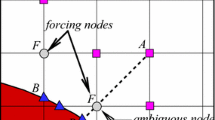Abstract
In this work we discuss an application of a distributed Lagrange multiplier based fictitious domain method, to the numerical simulation of the motion of rigid bodies settling in an incompressible viscous fluid. The solution method combines a third order finite element approximation, and time integration by operator splitting. Convergence results are shown for a simple Stokes flow with a circular rigid body that rotates with constant angular velocity. Results of numerical experiments for two sedimenting cylinders in a two-dimensional channel are presented. We present also results for the sedimentation of 100 and 504 cylinders.
Similar content being viewed by others
REFERENCES
Bertrand, F., Tanguy, P. A., and Thibault, F. (1997). A three-dimensional fictitious domain method for incompressible fluid flow problems. Int. J. Num. Meth. Fluids 25, 719–736.
Dean, E. J., and Glowinski, R. (1997). A wave equation approach to the numerical simulation of the Navier–Stokes equations for incompressible viscous flows. C. R. Acad. Sci. Paris 325, Série 1, 789–791.
Dean, E. J., Glowinski, R., and Pan, T. W. (1998). A wave equation approach to the numerical simulation of incompressible viscous flow modeled by the Navier–Stokes equations. In De Santo, J. A. (ed.), Mathematical and Numerical Aspects of Wave Propagation, SIAM, Philadelphia, PA, pp. 65–74.
Feng, J., Hu, H. H., and Joseph, D. D. (1994). Direct simulation of initial value problems for the motion of solid bodies in Newtonian fluid. Part 1. Sedimentation. J. Fluid Mech. 261, 95–134.
Girault, V., and Raviart, P.-A. (1986). Finite Element Methods for Navier–Stokes Equations, Springer, Berlin.
Glowinski, R., Pan, T. W., Hesla, T., Joseph, D. D., and Périaux, J. (2001). A fictitious domain approach to the direct numerical simulation of incompressible viscous flow past moving rigid bodies: Application to particulate flow. J. Comput. Phys. 169, 363–426.
Glowinski, R., and Le Tallec, P. (1989). Augmented Lagrangians and Operator Splitting Methods in Nonlinear Mechanics, SIAM, Philadelphia, PA.
Glowinski, R., Pan, T. W., Hesla, T., and Joseph, D. D. (1999). A distributed Lagrange multiplier/fictitious domain method for particulate flow. Int. J. Multiphas. Flow 25, 755–794.
Hu, H. H. (1996). Direct simulation of flows of solid-liquid mixtures. Int. J. Multiphas. Flow 22, 335–352.
Marchuk, G. I. (1990). Splitting and alternating direction methods. In Ciarlet, P. G., and Lions, J. L. (eds.), Handbook of Numerical Analysis, Vol. I, North-Holland, Amsterdam, pp. 197–462.
Pissanetzky, S. (1984). Sparse Matrix Technology, Academic Press.
Taylor, C., and Hood, P. (1973). A numerical solution of the Navier–Stokes equations using the finite element method. Comput. & Fluids 1, 73–100.
Author information
Authors and Affiliations
Rights and permissions
About this article
Cite this article
Juárez, L.H., Glowinski, R. & Pan, T.W. Numerical Simulation of the Sedimentation of Rigid Bodies in an Incompressible Viscous Fluid by Lagrange Multiplier/Fictitious Domain Methods Combined with the Taylor–Hood Finite Element Approximation. Journal of Scientific Computing 17, 683–694 (2002). https://doi.org/10.1023/A:1015191101744
Issue Date:
DOI: https://doi.org/10.1023/A:1015191101744




